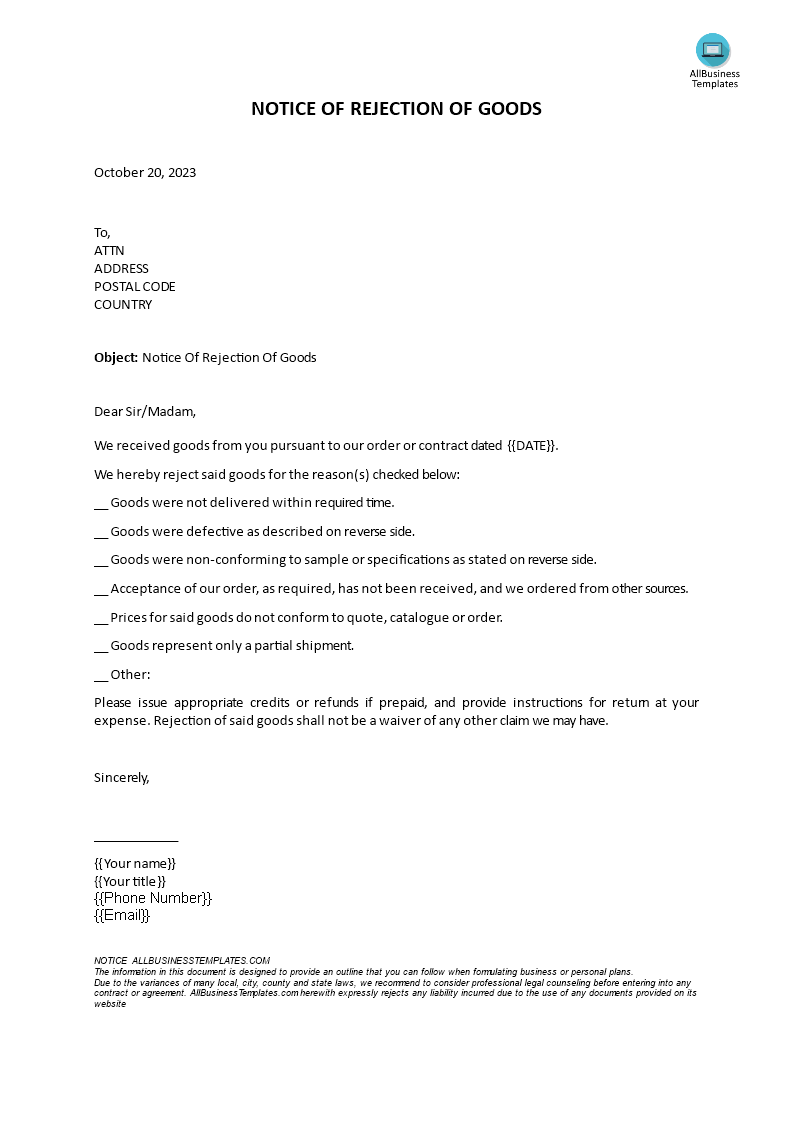Kennisgeving van afwijzing van goederen

Opslaan, invullen, afdrukken, klaar!
De beste manier om een Kennisgeving van afwijzing van goederen te maken? Check direct dit professionele Kennisgeving van afwijzing van goederen template!
Vandaag: USD 1.99
Download nu!

Beschikbare bestandsformaten:
.docx- Gevalideerd door een professional
- 100% aanpasbaar
- Taal: English
- Digitale download (23.31 kB)
- Na betaling ontvangt u direct de download link
- We raden aan dit bestand op uw computer te downloaden.
Zakelijk Verkoop kennisgeving van afkeuring van goederen afwijzingsbrief
Do you need a Notice of rejection of purchased goods? How do you interpret notice of rejection? This template can be used to reject goods that do not meet quality standards or that are not in the expected quantity. It can also be used to reject goods that were purchased from an unauthorized supplier. Download this professional Notice Of Rejection Of Goods template now!
The process for the rejection of goods typically involves a series of steps that a buyer or customer follows when they receive goods that do not meet their expectations, are damaged, or otherwise fail to conform to the agreed-upon specifications or terms of purchase. Here is a general process for the rejection of goods:
- Inspection of Goods Upon Receipt:
- Upon receiving the goods, the buyer or recipient should immediately inspect them for any visible damage, defects, or discrepancies from the order.
- Document the Issues:
- If any issues are identified during the inspection, they should be documented in detail. This documentation may include photographs, written descriptions, and any relevant order or shipment numbers.
- Review the Purchase Agreement:
- Refer to the purchase agreement, contract, or purchase order to confirm the agreed-upon specifications, quality standards, and terms of purchase. This step is crucial for assessing whether the received goods conform to the contract.
- Notify the Seller or Supplier:
- Contact the seller or supplier as soon as possible to notify them of the issues with the received goods. This notification should be in writing, such as an email or a formal letter, and should clearly outline the problems and reference the relevant order or contract.
- Request for Resolution:
- In the notification, specify the desired resolution or action you are seeking. Common requests include replacement of the goods, repair of defects, a refund, or a credit to your account.
- Provide Supporting Documentation:
- Attach any supporting documentation, such as photographs, inspection reports, or copies of the purchase agreement, to substantiate your claim.
- Arrange for Return or Inspection:
- Depending on the nature of the issues, the seller may request that the goods be returned for inspection or provide instructions for handling damaged or defective items. Follow their instructions accordingly.
- Communicate in Writing:
- Maintain written communication with the seller or supplier throughout the process. Keep records of all correspondence, including emails, letters, and notes from phone conversations.
- Await Seller's Response:
- Allow the seller or supplier a reasonable amount of time to respond to your complaint and provide a proposed resolution.
- Review Seller's Response:
- Review the seller's response to assess whether it aligns with your requested resolution and whether it adequately addresses the issues.
- Negotiation and Resolution:
- Engage in negotiations with the seller if necessary to reach a mutually acceptable resolution. Be prepared to compromise if appropriate.
- Formalize the Resolution:
- Once an agreement is reached, formalize the resolution in writing. This may involve signing a revised agreement, receiving a credit or refund, or confirming the replacement or repair of the goods.
- Take Action:
- Depending on the agreed-upon resolution, take the necessary actions, such as returning the rejected goods, receiving replacements, or processing refunds.
- Monitor the Resolution:
- Monitor the implementation of the resolution to ensure that it is carried out as agreed. Keep records of any actions taken and payments received.
- Closing Communication:
- Conclude the matter by confirming in writing that the issue has been resolved to your satisfaction. Express gratitude for their cooperation.
It's important to follow a systematic and documented process when rejecting goods to protect your rights as a buyer or customer and to facilitate a smooth resolution with the seller or supplier. If disputes persist, legal advice or mediation may be necessary to achieve a satisfactory outcome.
Download this professional Notice Of Rejection Of Goods template now!
DISCLAIMER
Hoewel all content met de grootste zorg is gecreërd, kan niets op deze pagina direct worden aangenomen als juridisch advies, noch is er een advocaat-client relatie van toepassing.
Laat een antwoord achter. Als u nog vragen of opmerkingen hebt, kunt u deze hieronder plaatsen.


